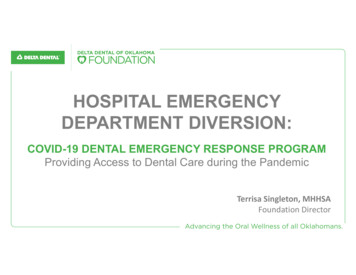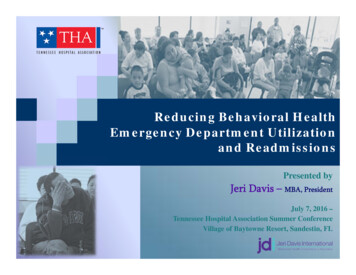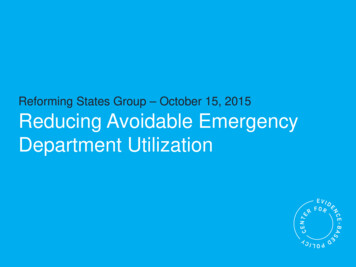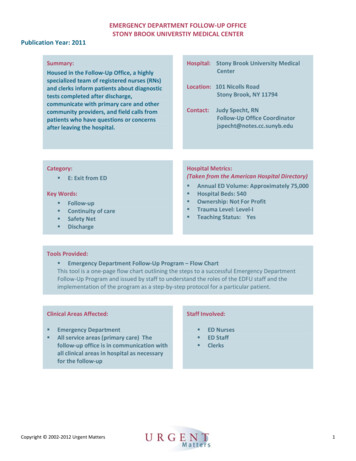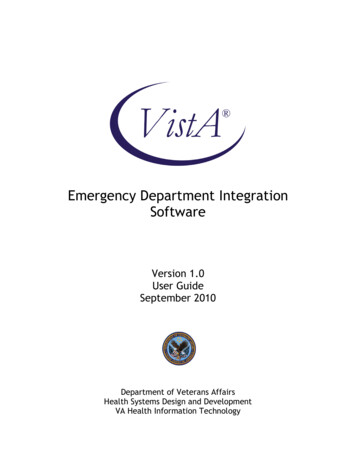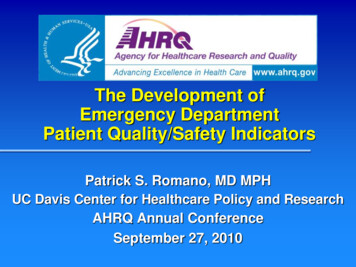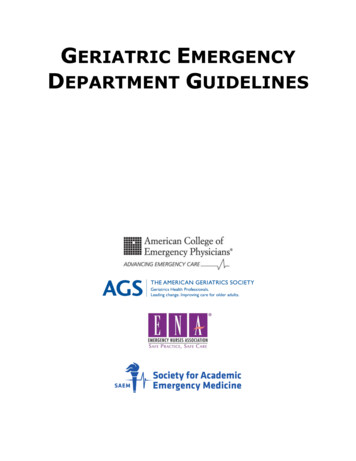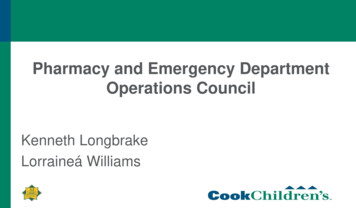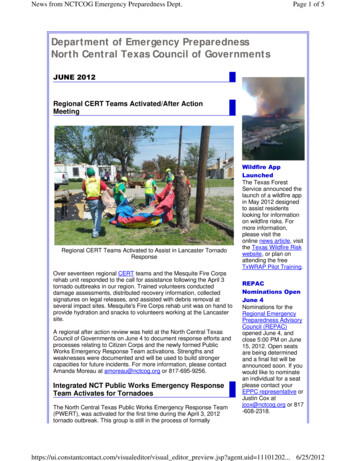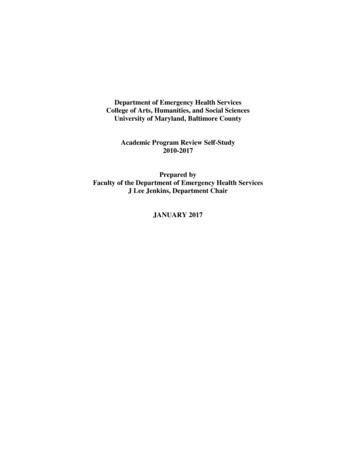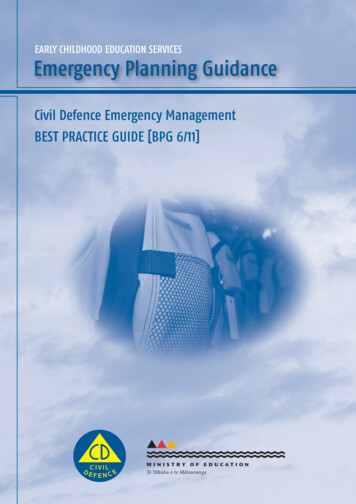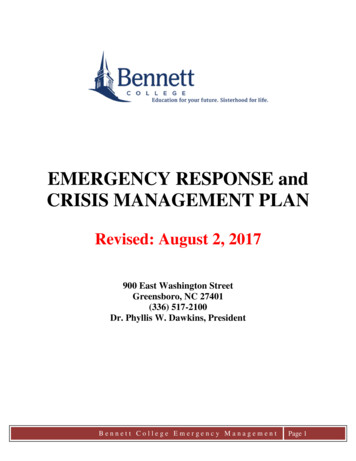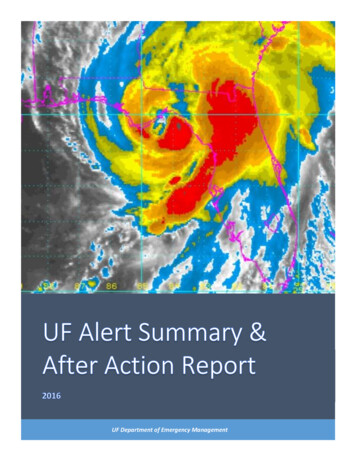
Transcription
UF Department of Emergency Management
OverviewThe University of Florida (UF) strives to provide an effective emergency notification and timely warningsystem for students, faculty, staff and visitors. The system, branded as UF Alert, is consistently reviewedand measured for performance. When a significant emergency or dangerous situation is immediatelyoccurring or threatening the health and safety of Campus, an emergency notification is issued. A timelywarning is sent when the incident represents a serious or continuing, but not immediate, threat tostudents and or employees. Messages are triggered by reports or confirmations of incidents within theUniversity’s Clery Act defined geography. Generally, these boundaries include “reasonably contiguous”areas of Campus as well as public sidewalks, streets and opposite sidewalks along the Campus borders.UF Alert services four specific areas: System-wide – The UF Alert-Systemwide service area provides notification to all locationsregarding significant impacts to University operations or schedules. Gainesville – The UF Alert-Gainesville service area includes the University campus as well asother Gainesville facilities such as East Campus. Shands – The UF Alert-Shands service area comprises the UF Health Shands Hospital complex onand adjacent to the University. Lake Nona - The UF Alert-Lake Nona service area covers the UF Lake Nona Research & AcademicCenter Facility near Orlando, Florida.This document contains a summary of notification activity for the 2016 calendar year as well as resultsfrom the annual UF Alert test. Additionally, Attachment 1 includes full message contents from all 2016UF Alerts.Summary of Calendar Year 2016 UF Alert MessagesUF issued a total of sixty (60) messaging covering thirty-two (32) separate incidents during the year. Thisnumber includes four (4) tests and twelve (12) timely warnings. Of the incidents, twenty-one (21) of thealerts were sent to UF Alert-Gainesville, six (6) to UF Alert-Shands, three (3) to UF Alert-Lake Nona andtwo (2) to UF Alert-Systemwide. The table below lists the incidents and number of associated messages.Message language for each of the notifications is documented in Attachment 1.Table 1: UF Alerts Issued During Calendar Year 2016Number ofMessagesDate IssuedUF AlertRecipient GroupArmed Robbery – West University Avenue201/31GainesvilleTimely Warning – Garage 8(Exposure of Sexual Organs)102/04GainesvilleRobbery – SW Archer Road502/07GainesvilleIncident2016 UF Alert SummaryPage 1
Timely Warning – Garage 6(Exposure of Sexual Organs)102/11GainesvilleTimely Warning – Reitz Union (Battery)104/05GainesvilleShands Alert – Test105/25ShandsTimely Warning – West University Avenue(Attempted Abduction)106/09GainesvilleTimely Warning – Newell Drive/Inner Road(Exposure of Sexual Organs)106/14GainesvilleTimely Warning – Little Hall(Exposure of Sexual Organs)106/23GainesvilleTimely Warning – Fraternity Row(Suspicious Van)206/27GainesvilleTimely Warning – West University Avenue(Sexual Battery)107/21GainesvilleTimely Warning (Follow-up to 07/21)107/22GainesvilleArmed Robbery – Shands Hospital1007/26GainesvilleShands Alert – Mass Casualty208/01ShandsShands Alert – IT Outage508/10ShandsHermine Closure209/01SystemwideHermine Opening109/02GainesvilleTimely Warning – NW 22nd Street(Sexual Battery)109/03GainesvilleTimely Warning – Unknown Location(Sexual Battery)109/12GainesvilleShands Alert – IT Outage209/14ShandsUF Alert Test109/30Lake NonaUF Alert Test110/05Lake NonaMatthew Closure210/05Systemwide2016 UF Alert SummaryPage 2
Matthew Closure (Lake Nona)110/05Lake NonaMatthew Closure210/06GainesvilleMatthew Shelter Opening110/06GainesvilleMatthew Closure210/06GainesvilleShands Alert – Hurricane Matthew110/06ShandsArmed Robbery – SW 4th Avenue310/22GainesvilleTimely Warning – SW 8th Avenue(Sexual Battery)110/30GainesvilleUF Alert Test111/17GainesvilleShands Alert – IT Outage211/26ShandsIncidents 32Messages 60UF Alert Users TrainingUsers of the UF Alert system, who are authorized to send messages, are provided regular education andtraining opportunities. For University Relations, UF Department of Emergency Management (UFDEM)conducts training on a quarterly basis, requiring users to log-in and initiate a test message from theInformaCast portal. University of Florida Police Police Communications Operators (PCOs) complete amonthly test administrated by the Police Communications Manager. PCOs must demonstrateproficiency on InformaCast as well as Blackboard Connect. All new operators are presented with anoverview training, outlining the UF Alert program and specific details of sending a message. Following anactual UF Alert, the sending PCO is provided with a written quality assurance review of performance andmessage wording. The purpose of the regular testing and training is to address and improve the humancomponent behind commencing an emergency notification. UF Health at Shands Hospital and Lake NonaResearch and Academic Center are responsible for training authorized senders for UF Alert-Shands andUF Alert-Lake Nona, respectively.2016 UF Alert SummaryPage 3
UF Alert Annual Test ResultsIn accordance with UF’s Annual Security and Fire SafetyReport, Together for a Safe Campus, as well as the JeanneClery Disclosure of Campus Security Policy and CampusCrime Statistics Act, a coordinated test of the UF Alertsystem was conducted during the fall semester. Theannounced test occurred on November 17th and activatedeach notification method – text messaging, email, VoIPmass notification, social media, web and RSS. The testmessage was sent via the integrated InformaCast portal.Specifically, this test activated messages directed tosubscribers of “UF Alert-Gainesville.” A UFPD PCO initiatedthe message, including recording the audio portion.SMS/Text MessagingText messaging is sent through an interface with the University’s vendor, Blackboard Connect. Thesystem attempted to deliver to 64,466 contacts. The text was initiated at 11:48AM and completed by12:08PM. Ninety-three percent (93%), or 59,824 devices, were successfully reached by the message. Themajority of the seven (7%) of the individuals who did not receive the message have either opted out ofreceiving texts from Blackboard or have entered an invalid telephone number in the MyUFL emergencycontact registry. This performance is in line with previous year, as depicted in Table 2. A detailed reportof the delivery results is provided in Table 3 below.Table 2: Annual Test Performance Comparison of Text Message Device Deliveries201491% (60,833 of 66,527 Contacts Successfully Reached)201592% (57,244 of 62,183 Contacts Successfully Reached)201693% (59,824 of 64,466 Contacts Successfully Reached)0%10%20%30%40%50%Successfully Reached2016 UF Alert SummaryPage 460%70%Did Not Reach80%90%100%
Table 3: SMS/Text Message Detailed Delivery RatesNumber of ContactsText Email Sent2,210Sent to Carrier3,076Delivery Confirmed54,538Text Opted-Out3,531Text pending Opt-In47Invalid Text Phone877International Text Not Enabled187Total 64,466Percentage of Total3%5%85%5%0%1%0%EmailFor the second straight year, performance demonstrated an ability to rapidly send emails. Over ninetynine percent (99%), or 65,003 of 65,124, of the emails were delivered by the end of the first minute.Table 4 compares email delivery execution against recent annual tests.Table 4: Annual Test Performance Comparison of Email Deliveries During Initial Five MinutesMinute 1Minute 2Minute 3Minute 4Minute 10,227141VoIP Mass NotificationA test audio and text message was sent to IP devices(telephones and speakers) maintained by all threecampus providers: Information and CommunicationTechnology (ICT), Academic Health Center (AHC)HealthNet and Housing & Residence Education. At thetime of the test, UF maintained over 16,000 IP devicesconnected to the InformaCast system.2016 UF Alert SummaryPage 5
Table 5: Detailed Results of IP Device PerformanceNetwork ServicesAHC-HealthNetTelecommunicationsNumber of activation attempts9,8836,077Number of activation successes9,8594,604Number of activation failures241,473Authentication errors030Network errors0413Unknown errors241,030Average time to activate a device0.759 seconds1.95 secondsMaximum time to activate a device10.54 seconds 20.133 secondsMinimum time to activate a device0.003 seconds0.004 secondsBroadcast initiated (HHMMSS)11:45:3011:48:04Broadcast finished (HHMMSS)11:49:4511:53:42Table 6: Annual Test Performance Comparison of IP Device DeliveriesNetwork ServicesAHC-HealthNetTelecommunications2016 2015 2014 2016 2015 2014Housing & ResidenceEducationSystem did notactivate during testHousing & ResidenceEducation2016 2015 2014Total Number of er of 40445407Percentage of SuccessfulDevice Activations99%99%99%76%72%70%0%96%98%Social MediaThe test message successfully posted to the UFAlert Facebook account(www.facebook.com/ufalert) as well as Twitteraccounts for UF Alert (@ufalert) and theUniversity of Florida (@uf). UF Alert currentlyhas 7,194 followers on Twitter and 4,307 likeson Facebook.GatorSafe AppThose with Android version of the GatorSafe App received a push notification of the test message.However, the push notification certificate had not been renewed with Apple preventing the messagefrom reaching those with iOS devices. The issue was immediately corrected with the assistance of thevendor, AppArmor, and a process put in place by UFIT to prevent future certificate lapses.2016 UF Alert SummaryPage 6
WebThe message effectively posted on the UF homepage (www.ufl.edu)during the test. The University’s homepage provides an easily availableoutlet for those internal or external to the institution to view UF Alerts.Additionally, the test appeared on the University’s mobile webapplication (m.ufl.edu) as well as the native University of Florida appsfor iPhone and Android phones.RSSAn RSS (Real Simple Syndication) feed was created when the testmessage was initiated, as is the case with all UF Alerts. These feedsallow anyone with a third-party RSS reader, such as Microsoft Outlookor most web browsers, to receive UF Alert messages.Areas for ImprovementThe University efforts to improve the emergency notification process and evaluation performancefollowing each UF Alert activation. Enhancement, both technical and training, are continually occurring.From the 2016 exercise, two areas were noted for improvement:Issue – iOS versions of the GatorSafe App did not receive a push notification of the test messagedue to expiration of the Apple certificate.Status – The certificate has been renewed and is working properly. AppArmor and UFIT haveestablished a process to renew the certificate on June 1st of each year.Issue – Successful InformaCast delivery rates to IP devices for AHC-HealthNet are below desiredperformance levelsStatus – AHC-HealthNet is working with Singlewire to improve performance. Actual deviceactivation results are believed to be higher than performance reporting logs from InformaCastdue to a technical issue.Issue – Housing and Residence Education IP devices did not activate during the test.Status – Housing and Residence Education upgraded to latest version of InformaCast andreconfigured distribution groups, resulting in successful deliveries of UF Alert messages sincethe November test.2016 UF Alert SummaryPage 7
UF Alert Program Goals and SuccessesSeveral long-terms goals are in place to drive enhancements and the future direction of the University’semergency notification program. These aspirations are primarily developed and carried out through theUF Alert Working Group. The Department of Emergency Management coordinates the group, whichnormally meets on a monthly basis. Below are the desired improvements over the next five-year periodas well as recently completed goals: Inclusion of Shands employees (completed) – UF Alert-Shands launched in 2016, serving the UFHealth at Shands Hospital area. Identity and Access Management changes were completed, allowingShands employees to receive any desired UF Alert location notifications and UF students andemployees are able to participate in UF Alert-Shands. Continued formalization of UF Alert-Lake Nona (completed) – In 2016, Lake Nona completed asecond annual test of their emergency notification system and issued notifications for HurricaneMatthew. The program is considered operational. Evaluation of WEBS Talk-A-Phone (completed) – In 2015 and 2016, UF installed six Talk-A-Phone(blue light) towers with Wide-Area Emergency Broadcast System (WEBS) which feature speakers foroutdoor notifications. The units have met performance expectations and future installationlocations are being determined. Development of IP device maintenance plan (on-going) – With the allocation of UF Alert-specificfunding during FY 2016/2017, a programmatic maintenance plan is being implemented with UFIT toproactively address UF Alert VoIP telephones and speakers installed in academic classrooms, classlaboratories and other student-focused areas. Integration of UF Alert-Jacksonville (on-going) – The emergency notification system for the UFHealth Science Center in Jacksonville is not incorporated into the UF Alert program. Ideally thesystems would share the same Identity and Access Management process for subscribing as well asbranding and notification methods. Review of SMS/Text Messaging (on-going) – In calendar 2017, an evaluation and potentialprocurement of SMS/text messaging vendors will be conducted. The review will consider speed ofdelivery, costs, usability, customer server and integration with other UF Alert components.2016 UF Alert SummaryPage 8
Attachment 1 – UF Alert Messages Sent During the Calendar Year 2016(Message Content from UF Alert Emails)UF Alert-GainesvilleSunday, January 31, 2016, 11:50PMArmed Robbery at off campus
UF Alerts. Summary of Calendar Year 2016 UF Alert Messages UF issued a total of sixty (60) messaging covering thirty-two (32) separate incidents during the year. This number includes four (4) tests and twelve (12) timely warnings. Of the incidents, twenty-one (21) of the alerts were sent to UF Alert-Gainesville, six (6) to UF Alert-Shands, three (3) to UF Alert-Lake Nona and two (2) to UF .
